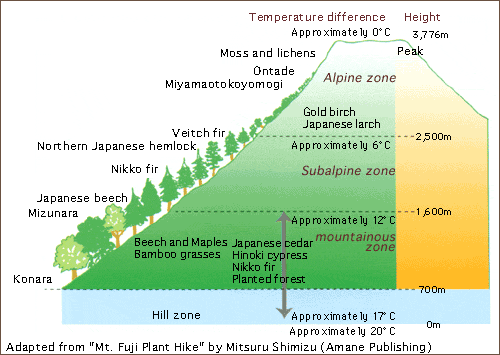Saturday, March 26, 2011
Conservation Effort done for Mount Fuji
Trash—from food wrappers left behind by visitors to tyres and old washing machines dumped by locals—is evident from Fuji’s base to its summit. Mount Fuji requires a significant waste-management system. Japanese citizens and organizations responded by launching clean-up campaigns. Each year thousands of people—Japanese families, students, environmental groups and corporate employees, along with foreign volunteers—converge on Mount Fuji to pick up trash. The Fujisan club sponsors clean-up days throughout the year; in 2006, volunteers picked up nearly 80 tons of trash! In response to the sewage problems, the Fujisan Club has set up bio-toilets along the route to the summit. The toilets use cedar chips and microorganisms to break down human waste. What we can do is if you visit Mount Fuji, lend your help to the clean-up efforts: pick up any trash you see and use only the environment-friendly toilets. :)
We must make effort to ensure the sustainability of Mount Fuji's environment, not just for ourselves, but also for future generations.
The Governors of Shizuoka and Yamanashi Prefectures agree to the following aims to preserve the natural environment of Mount Fuji:
The Governors of Shizuoka and Yamanashi Prefectures agree to the following aims to preserve the natural environment of Mount Fuji:
- Learn about and be familiar with the nature of Mt.Fuji and be thankful for its abundant gifts.
- Cherish and protect its beautiful nature, thus cultivating an enriched culture.
- Strive to reduce the burdens on the natural environment and live in harmony with Mt. Fuji.
- Each individual should actively work towards preservation of its environment.
- Pass on the nature,scenery,history and culture of Mt.Fuji to future generation.
Friday, March 25, 2011
What is special about Mount Fuji?
Mount Fuji is also like other mountains in Japan, regarded as having its own soul. While many objects in nature, like the trees and streams, can be worshipped in Shintoism, mountains are naturally the most prominent. Since Mount Fuji is so visible, it's the most important mountain-diety. Thousands of people climb Mount Fuji on special days, e.g. New Year's Day, to pray for good fortune, etc. However, on the flip side, it's also a very popular suicide location.
http://www.quora.com/Mount-Fuji/What-is-the-special-significance-of-Mount-Fuji
http://wiki.answers.com/Q/What_is_special_about_Mt_Fuji#ixzz1HcJZRds6
http://www.quora.com/Mount-Fuji/What-is-the-special-significance-of-Mount-Fuji
Mount Fuji is the heart of japan
At 3,776 meters, Mount Fuji is also the highest point in Japan, and it is a volcano with a distinctive conical shape that stands out spectacularly from the surrounding landscape. If you are lucky, you can get a great view of it from an airplane as you are coming into the country. Mount Fuji is always crowned with a magnificent view of snow. It is estimated that 200,000 people climb Mount Fuji every year. Mount Fuji is the symbol of Japan.
Who lives on Mount Fuji?
Since ancient times, Mt. Fuji had big eruption several times. It blew huge amount of volcanic lava and ash. these lava formed the huge skirts plane around the Mt.Fuji.This is called Fuji Susono. Later on, people started to dwell this area because the terrain is flat and soil is rich.
http://answers.yahoo.com/question/index?qid=20110227023431AAb8ByM
http://answers.yahoo.com/question/index?qid=20110227023431AAb8ByM
Monday, March 21, 2011
Natural Vegetation of Mount Fuji
Mount Fuji is a precious place where we can continuously observe the vertical distribution of vegetation zones. You cannot observe alpine plants anymore at a lower altitude than at other mountains. Even at the same altitude, vegetation varies depending on the timing of eruption or the components of lava. The forest line of Fuji is said to be around at 2,400-meter elevation but it varies depending on location.
Climate of Mount Fuji
Excluding parts of summer, the monthly average temperature at Mt. Fuji's peak is almost always below freezing and the annual average temperature is -7.1oC. The lowest recorded temperature is −38.0 °C! There is a 22oC average difference throughout the year between the level ground of Mishima and Mt. Fuji's peak. The average snow depth is 188cm.
Strong winds are characteristic at Mt. Fuji's peak. The west-northwest or west wind blows throughout the year and the annual average wind velocity is 12 meters per second.
Strong winds are characteristic at Mt. Fuji's peak. The west-northwest or west wind blows throughout the year and the annual average wind velocity is 12 meters per second.
Clouds are formed when warm air and water vapor hit the mountain, making air drift up the incline and the vapor become concentrated. Clouds formed when crossing the mountain are called "kasagumo" while clouds generated after crossing are called "tsurushigumo." It is said that they are a sign the weather is about to change.
Kasagumo
tsurushigumo
http://www.fujisan-net.gr.jp/english/4_03.htm
Introduction of Mount Fuji
Have you ever been to Mount Fuji? Mount Fuji lies about 100 kilometres (60 miles) south-west of Tokyo, Japan, Asia. It resides on Honshu, the largest of the Japanese islands. The Eurasian plate, Philippine plate and North American plate are involved in the forming of Mount Fuji.
It can be seen from there on a clear day. It is a dormant volcano that last erupted in 1707–08. Mount Fuji's exceptionally symmetrical cone is a well-known symbol of Japan. It is one of Japan's "Three Holy Mountains" along with Mount Tate and Mount Haku. Mount Fuji is a shield volcano, which gives it the beautiful shape. A shield volcano is one where the lava is thicker, and flows evenly from the vent. It builds up slowly, layer by layer.
It can be seen from there on a clear day. It is a dormant volcano that last erupted in 1707–08. Mount Fuji's exceptionally symmetrical cone is a well-known symbol of Japan. It is one of Japan's "Three Holy Mountains" along with Mount Tate and Mount Haku. Mount Fuji is a shield volcano, which gives it the beautiful shape. A shield volcano is one where the lava is thicker, and flows evenly from the vent. It builds up slowly, layer by layer.
http://en.wikipedia.org/wiki/Mount_Fuji
Subscribe to:
Comments (Atom)











